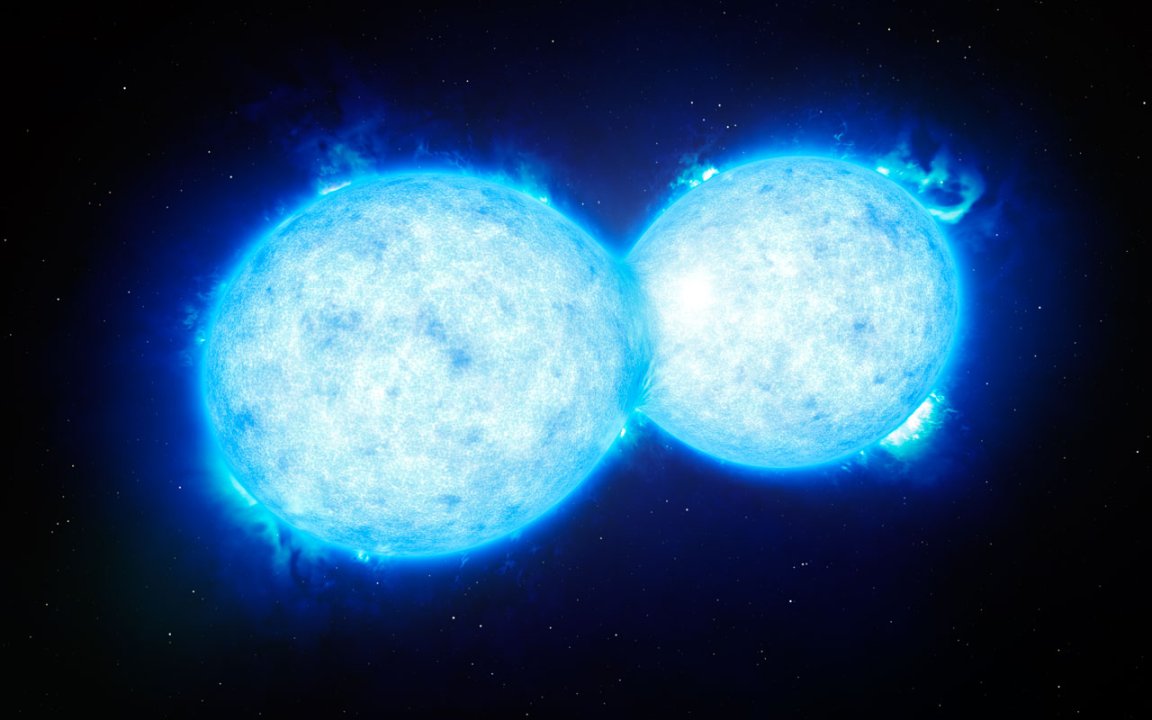
We know that there are binary stars. In fact, we know that there are a lot of binary stars. According to NASA, 2 out of every 3 stars has a solar neighbor in close proximity; however, most binary systems don’t orbit quite this close.
Recently, the ESO (European Space Observatory) announced that it discovered the hottest and most massive double star in the known universe. These stars are so close that they are overlapping, coming together in an embrace that will, ultimately, lead to their destruction.
The pair in question is known as VFTS 352, and they are true titans of the cosmos. Although our star may seem rather large to us, compared to VFTS 352, it’s actually just a baby. This pair has a combined mass that is some 57 times that of the Sun. If that’s not enough, they have surface temperatures above 40,000 degrees Celsius (72,000 degrees Fahrenheit). For comparison, the surface of the Sun is just 10,000 Fahrenheit (5,600 Celsius).
As an interesting aside, even this duo could be considered small, relatively speaking, as the most massive star is the known universe, R136a1, is a staggering 320 solar masses.
The stars were spotted by an astronomical team thanks to the ESO’s Very Large Telescope (VLT).
Located about 160,000 light-years away from Earth, in the Tarantula Nebula, the two stars orbit each other at amazing speeds. They complete a revolution in just over one Earth day (making their year equivalent to a day on our own planet). This short orbital period is made possible because of the close proximity of the two stellar heavyweights.
Ultimately, the stellar cores are only about 7.5 million miles (12 million km) apart. For comparison, Mercury, the closest planet to the Sun, orbits at a distance of some 36.8 million miles (59.2 million km). Indeed, the stars in VFTS 352 are so close that gravity creates a bridge between the two. Material from one blends with material from the other, forming a kind of stellar chimera.
And as previously mentioned, this embrace is a deadly one.
Scientists have two primary ideas regarding what this close proximity will eventually lead to. The first asserts that the two stars will one day merge and, in so doing, create a single gigantic star. This fusion means that each star would lose itself in light of the greater whole, and it would create quite the explosion.
The stellar fireworks would result from the amazingly fast rotation of the object, “If it keeps spinning rapidly, it might end its life in one of the most energetic explosions in the universe, known as a long-duration gamma-ray burst,” Hugues Sana, of the University of Leuven in Belgium, said in the ESO press release.
The second idea states that the two stars will not merge. Instead, they will remain compact and end their lives as supernova blasts. The team’s lead theoretical astrophysicist, Selma de Mink, states that this would cause the stars to transition into one of the most perplexing objects in the known universe: A black hole. If true, the gravitational disturbances caused by this event could provide astronomers with a great opportunity for astronomers. de Mink notes, “The components would likely end their lives in supernova explosions, forming a close binary system of black holes. Such a remarkable object would be an intense source of gravitational waves.”
For now, we will need to just wait and see.